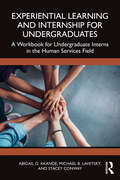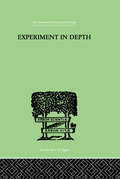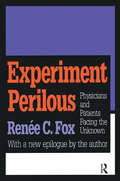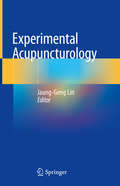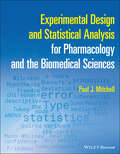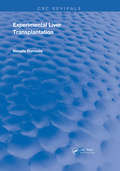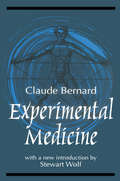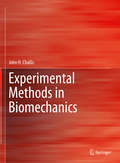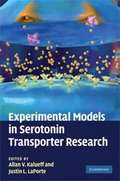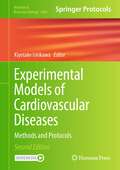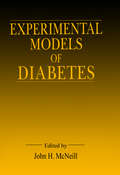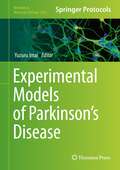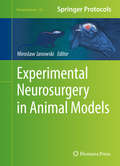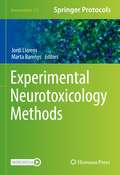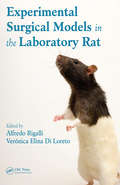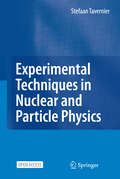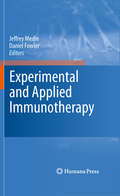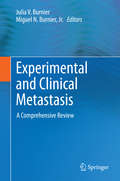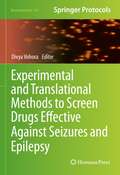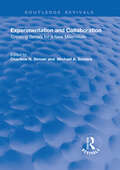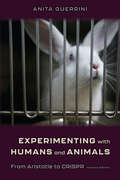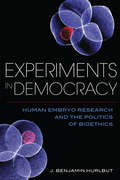- Table View
- List View
Experiential Learning and Internship for Undergraduates: A Workbook for Undergraduate Interns in the Human Services Field
by Abigail O. Akande Michael B. Lavetsky Stacey ConwayThis textbook is a comprehensive and sequential guide designed specifically for undergraduate students entering internships in the human services field and for the faculty serving as their internship supervisors. With a strong focus on career development and self-exploration, it builds understanding of the theoretical knowledge and core competencies needed for practical, clinical experience in a variety of human services positions such as rehabilitation, social work, case management, counseling, and criminal justice.Through a variety of exercises and activities in an effective workbook format, this book assists student interns in developing a better sense of self in relation to their career readiness and helps them to identify career paths in the human services field. It goes on to support them in developing the soft skills necessary to navigate professional careers and gives guidance on how to secure undergraduate internships in the human services field. The book focuses on how to develop the tools needed to succeed, from counseling skills, case management, and crisis management to ethical conduct, multicultural considerations, self-care, legislation, and working under supervision. It is accompanied by downloadable versions of all the exercises and activities which will be available for instructors using this book as a course text.By targeting the career exploration content that is vital in the experience of undergraduates who are seeking professions in such a broad human services field, it will be essential reading for students at this level. It is also a valuable resource for internship or practicum instructors in undergraduate programs, with a focus on rehabilitation, human services, social work, psychology, criminal justice, and other related helping fields.
Experiment In Depth: A STUDY OF THE WORK OF JUNG, ELIOT AND TOYNBEE (International Library Of Psychology Ser.)
by Martin, P WFirst published in 1999. Routledge is an imprint of Taylor & Francis, an informa company.
Experiment Perilous: Physicians and Patients Facing the Unknown
by Renee C. Fox"This is a brilliant work of lasting value to both sociology and anthropology by a person combining the talent of keen observer with the highest level of theoretical sophistication. . . a major contribution to our understanding of the nature and structure of a significant social situation."--David M. Schneider, The University of Chicago. Experiment Perilous covers a three-year period In the lives of the patients and physicians in a small and intense hospital community. It represents a pioneering, participant-observation-based study of a hospital ward as a social system. In a new epilogue. Fox provides a historical and sociological account of phenomena relevant to clinical investigations that she has observed in her forty-five years as a sociologist of medicine.
Experimental Acupuncturology
by Jaung-Geng LinThis book focuses on the use of acupuncture as a possible and alternative treatment in analgesia, drug addiction, depression, itchiness, peripheral nerve regeneration, stroke, diabetes, cognitive deficits and sleep regulation. Formal recognition by WHO and UNESCO concerning the use and efficacy of acupuncture science in modern medicine has encouraged high levels of investment and commitment to research and development activities into acupuncture science from several top-level health science research and treatment institutes in China Mainland, Taiwan, Japan, Korea, France and the USA. This book aims to provide direction and guidance on how the medical community can proceed with acupuncturology in modern medical treatment and precision medicine.
Experimental Design and Reproducibility in Preclinical Animal Studies (Laboratory Animal Science and Medicine #1)
by José M. Sánchez Morgado Aurora BrønstadThis highly-readable text provides grounds on how to plan and conduct animal experiments that can be reproduced by others. The book touches on factors that may impact the reproducibility of animal studies including: the animal genetic background, the animal microbial flora, environmental and physiological variables affecting the animal, animal welfare, statistics and experimental design, systematic reviews of animal studies, and the publishing process. The book addresses advanced undergraduates, graduate students and all scientists working with animals.
Experimental Design and Statistical Analysis for Pharmacology and the Biomedical Sciences
by Paul J. MitchellExperimental Design and Statistical Analysis for Pharmacology and the Biomedical Sciences A practical guide to the use of basic principles of experimental design and statistical analysis in pharmacology Experimental Design and Statistical Analysis for Pharmacology and the Biomedical Sciences provides clear instructions on applying statistical analysis techniques to pharmacological data. Written by an experimental pharmacologist with decades of experience teaching statistics and designing preclinical experiments, this reader-friendly volume explains the variety of statistical tests that researchers require to analyze data and draw correct conclusions. Detailed, yet accessible, chapters explain how to determine the appropriate statistical tool for a particular type of data, run the statistical test, and analyze and interpret the results. By first introducing basic principles of experimental design and statistical analysis, the author then guides readers through descriptive and inferential statistics, analysis of variance, correlation and regression analysis, general linear modelling, and more. Lastly, throughout the textbook are numerous examples from molecular, cellular, in vitro, and in vivo pharmacology which highlight the importance of rigorous statistical analysis in real-world pharmacological and biomedical research. This textbook also: Describes the rigorous statistical approach needed for publication in scientific journals Covers a wide range of statistical concepts and methods, such as standard normal distribution, data confidence intervals, and post hoc and a priori analysis Discusses practical aspects of data collection, identification, and presentation Features images of the output from common statistical packages, including GraphPad Prism, Invivo Stat, MiniTab and SPSS Experimental Design and Statistical Analysis for Pharmacology and the Biomedical Sciences is an invaluable reference and guide for undergraduate and graduate students, post-doctoral researchers, and lecturers in pharmacology and allied subjects in the life sciences.
Experimental Liver Transplantation (Routledge Revivals)
by Naoshi KamadaFirst Published in 1988, Experimental Liver Transplantation is a helpful guide through the process of Liver Transplantation and how the surgical techniques have evolved over the years. Filled with references to the history of Liver transplantation, to the experimental procedures performed on rats. This is an essential guide to any students of surgery or professionals in their respective fields.
Experimental Medicine (Dover Books On Biology Ser.)
by Claude Bernard Stewart WolfThe French physiologist Claude Bernard was responisble for investigating the chemical phenomena of digestion. This text reproduces his research into experimental medicine. A new introduction looks at his impact on the world of medicine.
Experimental Metastasis: Modeling and Analysis
by Anastasia MalekMetastatic dissemination of cancer is a main cause of cancer related deaths, therefore biological mechanisms implicated in metastatic process presents an essential object of cancer research. This research requires creation and utilization of adequate laboratory models. The book describes main approaches to model processes of metastatic cancer dissemination and metastases development. The book is structured in according with various metastatic pathways reflecting molecular specificity of metastatic process as well as anatomical specificity of aria of dissemination. Each chapter is introduced by short discussion of clinical aspects of certain metastatic pathway. Especial attention is paid for methods of visualization, quantification and analysis of the modeled metastases. Additional chapter is devoted to methods of mathematic modeling of tumor spread. The data presented in the book may be helpful for cancer researchers and oncologists.
Experimental Methods in Biomechanics
by John H. ChallisThis is the first textbook to comprehensively cover the experimental methods used in biomechanics. Designed for graduate students and researchers studying human biomechanics at the whole-body level, the book introduces readers to the theory behind the primary data collection methods and primary methods of data processing and analysis used in biomechanics. Each individual chapter covers a different aspect of data collection or data processing, presenting an overview of the topic at hand and explaining the math required for understanding the topic. A series of appendices provide the specific math that is required for understanding the chapter contents. Each chapter leads readers through the techniques used for data collection and processing, providing sufficient theoretical background to understand both the how and why of these techniques. Chapters end with a set of review questions, and then a bibliography which is divided into three sections (cited references, specific references, and useful references).Provides a comprehensive and in depth presentation on methods in whole-body human biomechanics;First textbook to cover both collection and processing in a single volume;Appendices provide the math needed for the main chapters.
Experimental Models in Serotonin Transporter Research
by Allan V. Kalueff Justin L. LaporteThe serotonin transporter is a key brain protein that modulates the reuptake of the neurotransmitter serotonin from synaptic spaces back into the presynaptic neuron. This control over neuronal signalling makes it a prime area of neuroscientific study. In this book an international team of top experts introduce and explicate the role of serotonin and the serotonin transporter in both human and animal brains. They demonstrate the relevance of the transporter and indeed the serotonergic system to substrates of neuropsychiatric disorders, and explain how this knowledge is translated into valid animal models that will help foster new discoveries in human neurobiology. Writing for graduate students and academic researchers, they provide a comprehensive coverage of a wide spectrum of data from animal experimentation to clinical psychiatry, creating the only book exclusively dedicated to this exciting new avenue of brain research.
Experimental Models of Cardiovascular Diseases: Methods and Protocols (Methods in Molecular Biology #2803)
by Kiyotake IshikawaThis second edition provides new and updated methods for establishing reliable and reproducible experimental models of cardiovascular diseases. Chapters detail practical protocols from expert laboratories focusing on cardiovascular research, that would be critical in exploring novel discoveries in cardiac biology, and the development of effective therapeutic approaches. Written in the highly successful Methods in Molecular Biology series format, chapters include introductions to their respective topics, lists of the necessary materials and reagents, step-by-step, readily reproducible laboratory protocols, and key tips on troubleshooting and avoiding known pitfalls. Authoritative and cutting-edge, Experimental Models of Cardiovascular Diseases: Methods and Protocols, Second Edition aims to provide detailed and practical protocols that will be valuable tools for researchers in cardiology to conduct their research.
Experimental Models of Diabetes
by John H. McNeillAn extremely useful text for research Internationally renowned experts describe the models, provide data obtained with those models, and discuss the relative usefulness of models in relation to the diabetic syndrome in humans. The first section examines the most widely used model, the streptozotocin (STZ) rat, condensing a massive quantity of literature to present both the general effects of of STZ diabetes and the effects on individual organ systems. The second section discusses less well-known and more recent diabetic models, such as the BB rat, the NOD mouse and Zucker and Zucker Diabetic Fatty rat models. Genetic models of insulin dependent diabetes mellitus (IDDM) are examined and compared to chemically induced IDDM models.
Experimental Models of Parkinson’s Disease (Methods in Molecular Biology #2322)
by Yuzuru ImaiThis detailed book focuses on cutting-edge methods for Parkinson’s disease (PD) research, such as the analysis of the prion-like properties of α-synuclein, mitochondrial functions related to the PINK1-Parkin pathway/CHCHD2, the endolysosome pathway related to LRRK2, VPS35, and ATP13A2 using cultured cells (including patient iPS cells), deep brain stimulation therapy, classic mitochondrial toxins related to PD, and genetic associations and screenings using mammalian and invertebrate genetic models of PD. The collection intends to serve as an introductory protocol book for basic research on PD pathogenesis. Written for the highly successful Methods in Molecular Biology series, chapters include introductions to their respective topics, lists of the necessary materials and reagents, step-by-step, readily reproducible laboratory protocols, and tips on troubleshooting and avoiding known pitfalls. Authoritative and practical, Experimental Models of Parkinson's Disease is an ideal guide for researchers continuing to work toward making PD risk predictable and surmountable.
Experimental Neurosurgery in Animal Models
by Miroslaw JanowskiThis volume provides a full explanation and technical details to perform surgical techniques properly on small and large animal models. The first six chapters of" Experimental Neurosurgery in Animal Models" focus primarily on the brain, while the next six chapters concern the spinal cord in rodents. The last four chapters provide a description of operative procedures in large animals. Written for the popular "Neuromethods" series, chapters include the kind of detail and key implementation advice that ensures successful results in the laboratory. Authoritative and practical, "Experimental Neurosurgery in Animal Models" aims" "to ensure successful results in the further study of this vital field.
Experimental Neurotoxicology Methods (Neuromethods #172)
by Jordi Llorens Marta BarenysThis volume explores the latest methods that seek to address the vital questions being asked in neurotoxicology research. The chapters in this book cover a variety of available methods from the molecular level to the organism level, and both in vitro and in vivo approaches, including alternative model organisms. In the Neuromethods series style, chapters include the kind of detail and key advice from the specialists needed to get successful results in your laboratory.Cutting-edge and authoritative, Experimental Neurotoxicology Methods is a valuable resource for both young and experienced researchers who are looking for guidance to implement these methods in their laboratories or for understanding the data generated through these techniques.
Experimental Surgical Models in the Laboratory Rat
by Alfredo Rigalli Verónica Elina Di LoretoAn All-Inclusive Guide to Surgical Techniques on RatsThe design of an adequate surgical model, like the choice of the animal model itself, is extremely important for obtaining reliable valuable data. Experimental Surgical Models in the Laboratory Rat summarizes a series of techniques that were applied in the Bone Biology Laboratories, School of Medicine, Rosario National University, Argentina. Stopping just short of an exhaustive analysis of the techniques, this manual describes the basics of each surgical technique, the necessary materials, precautions to consider, the methodology to apply, and the possible results to be obtained in similar experiments.CD-ROM: 250 Illustrations of Surgery Techniques with Step-by-Step InstructionWith succinct descriptions, color photographs, and easy-to-follow steps, the downloadable resources are a practical, full-color roadmap for performing various surgery techniques, such as catheterization, tracheostomy, intramuscular injection, subcutaneous injection, intraperitoneal injection, and oral intubation. This definitive work provides technical and practical data including volumes and concentrations of solutions, catheters used, equipment, and biological variables on the rat. Experimental Surgical Models in the Laboratory Rat is a complete reference for today’s biomedical sciences investigator.
Experimental Techniques in Nuclear and Particle Physics
by Stefaan TavernierI have been teaching courses on experimental techniques in nuclear and particle physics to master students in physics and in engineering for many years. This book grew out of the lecture notes I made for these students. The physics and engineering students have rather different expectations of what such a course should be like. I hope that I have nevertheless managed to write a book that can satisfy the needs of these different target audiences. The lectures themselves, of course, need to be adapted to the needs of each group of students. An engineering student will not qu- tion a statement like “the velocity of the electrons in atoms is ?1% of the velocity of light”, a physics student will. Regarding units, I have written factors h and c explicitly in all equations throughout the book. For physics students it would be preferable to use the convention that is common in physics and omit these constants in the equations, but that would probably be confusing for the engineering students. Physics students tend to be more interested in theoretical physics courses. However, physics is an experimental science and physics students should und- stand how experiments work, and be able to make experiments work.This is an open access book.
Experimental and Applied Immunotherapy
by Daniel Fowler Jeffrey MedinImmunotherapy is now recognized as an essential component of treatment for a wide variety of cancers. It is an interdisciplinary field that is critically dependent upon an improved understanding of a vast network of cross-regulatory cellular populations and a diversity of molecular effectors; it is a leading example of translational medicine with a favorable concept-to-clinical-trial timeframe of just a few years. There are many established immunotherapies already in existence, but there are exciting new cancer immunotherapies just on the horizon, which are likely to be more potent, less toxic and more cost effective than many therapies currently in use. Experimental and Applied Immunotherapy is a state-of-the-art text offering a roadmap leading to the creation of these future cancer-fighting immunotherapies. It includes essays by leading researchers that cover a wide variety of topics including T cell and non-T cell therapy, monoclonal antibody therapy, dendritic cell-based cancer vaccines, mesenchymal stromal cells, negative regulators in cancer immunology and immunotherapy, non-cellular aspects of cancer immunotherapy, the combining of cancer vaccines with conventional therapies, the combining of oncolytic viruses with cancer immunotherapy, transplantation, and more. The field of immunotherapy holds great promise that will soon come to fruition if creative investigators can bridge seemingly disparate disciplines, such as T cell therapy, gene therapy, and transplantation therapy. This text is a vital tool in the building of that bridge.
Experimental and Clinical Metastasis
by Julia V. Burnier Miguel N BurnierMetastatic disease is the most lethal aspect of human malignancies, making the understanding and continued research of the process of metastasis a crucial step in treating cancer. The proposed book, entitled "Experimental and Clinical Metastasis: A Comprehensive Review" aims to provide a clear and extensive review of the clinical and experimental implications of metastatic disease. This work focuses on recent contributions to the field of metastasis, and will highlight crucial findings in the molecular understanding of disseminated disease as well as standard and personalized medicine currently being investigated in the clinic. Topics will include, among many, gene properties of metastatic cells, molecular mechanisms of tumour growth and spread, animal models of metastasis, and clinical implications, markers and treatment for metastatic disease. With the participation of worldwide experts in the field of oncology, from major academic and government centres, this book will provide a leading manual for the study of the metastatic process, from benchside science to bedside care. In this light, the proposed book will facilitate classroom learning for both medical and graduate students, as well as serve as a tool for physicians and researchers interested in the metastatic process. In addition, this book will include the latest advances in basic science as well as leading technologies and theories of targeting metastatic cells. Most importantly, not only will basic and clinical aspects be discussed, but furthermore, the translational aspect of research in metastatic diseases will be emphasized.
Experimental and Translational Methods to Screen Drugs Effective Against Seizures and Epilepsy (Neuromethods #167)
by Divya VohoraThis volume discusses the latest experimental and clinical approaches to study seizures and epilepsy. Chapters in this book cover detailed protocols for ex vivo and in vitro experimental models and widely-used in vivo (acute and chronic seizure) models in epilepsy research. Chapters also cover techniques to screen the effective leads for the treatment of refractory seizures of pharmacoresistant epilepsy and invertebrate, non-mammalian models. In the Neuromethods series style, chapters include the kind of detail and key advice from the specialists needed to get successful results in your laboratory. Cutting-edge and practical, Experimental and Translational Methods to Screen Drugs Effective Against Seizures and Epilepsy is a valuable resource for researchers, in both industry and academia, interested in learning about this important and developing field.
Experimentation and Collaboration: Creating Serials for a New Millenium
by Charlene N. Simser Michael A. SomersExperimentation and Collaboration: Creating Serials for a New Millennium will help you see the current direction of serials collection, development, creation, and production as we travel with the electronic age into the dawn of the next millennium. You'll get instant access to the many ways in which traditional boundaries between academic libraries and computer services are dissolving, and you'll see the new sense of egalitarianism that's enhancing scholarship and scholarly communication as the next thousand years approaches. In Experimentation and Collaboration, you'll be transported instantly to all the best NASIG plenary, project, and issues sessions and workshops you might have missed, such as: surviving scholarhip in the 21st Century building a national electronic collection for long-term access creating an electronic archive understanding initiatives in Internet cataloging finding innovations in journal access surmounting the challenges of managing and delivering e-journals drumming up motivation for staff in changing times handling copyright issues and Web publishingOverall, the 12th Annual NASIG Conference was a grand affair, bringing over 600 publishers, vendors, and librarians to Ann Arbor from America, Canada, and Mexico, as well as Great Britain, Germany, and Australia. Experimentation and Collaboration gives you the full range of acitivites at this important conference and ensures that you'll be able to collaborate on, experiment with, and create new serials with the rest of the scholarly world as we begin a new electronic era of information provision, serials publishing, and library science.
Experimenting with Humans and Animals: From Aristotle to CRISPR (Johns Hopkins Introductory Studies in the History of Science)
by Anita GuerriniExamining the ideas and attitudes that encourage scientists to experiment on living creatures, what their justifications are, and how these have changed over time.Experimentation on animals—particularly humans—is often assumed to be a uniquely modern phenomenon. But the ideas and attitudes that encourage biological and medical scientists to experiment on living creatures date from the earliest expressions of Western thought. In Experimenting with Humans and Animals, Anita Guerrini looks at the history of these practices and examines the philosophical and ethical arguments that justified them.Guerrini discusses key historical episodes in the use of living beings in science and medicine, including the discovery of blood circulation, the development of smallpox and polio vaccines, and recent research in genetics, ecology, and animal behavior. She also explores the rise of the antivivisection movement in Victorian England, the modern animal rights movement, and current debates over gene therapy and genetically engineered animals. We learn how perceptions and understandings of human and animal pain have changed; how ideas of class, race, and gender have defined the human research subject; and that the ethical values of science seldom stray far from the society in which scientists live and work.Thoroughly rewritten and updated, with new material in every chapter, the book emphasizes a broader understanding of experimentation and adds material on gene therapy, self-experimentation, and prisoners and slaves as experimental subjects. A new chapter brings the story up to the present while reflecting on the current regulatory scene, new developments in science, and emerging genomics. Experimenting with Humans and Animals offers readers a context within which to understand more fully the responsibility we all bear for the suffering inflicted on other living beings in the name of scientific knowledge.
Experimenting with Humans and Animals: From Galen to Animal Rights (Johns Hopkins Introductory Studies In The History Ser.)
by Anita GuerriniExperimentation on animals and particularly humans is often assumed to be a uniquely modern phenomenon. But the ideas and attitudes that encourage the biological and medical sciences to experiment on living creatures date from the earliest expression of Western thought. <p><p> In Animal and Human Experimentation, the author looks at the history of these practices from vivisection in ancient Alexandria to present-day battles over animal rights and medical research employing human subjects. The author discusses in-depth key historical episodes in the use of living beings in science and medicine, including the discovery of blood circulation, the development of smallpox and polio vaccines, and recent AIDS research. <p><p> She also explores the rise of the antivivisection movement in Victorian England, the modern animal rights movement, and current debates over gene therapy. In this highly accessible text, we learn how our understanding of an animal's capacity to feel pain has evolved. The author reminds us that the ethical values of science seldom stray far from those of the society in which scientists live and work. Ethical questions about the use of animals and humans in research remain among the most vexing within both the scientific community and society at large. These often rancorous arguments have gone on, however, with little awareness of their historical antecedents. <p><p> Animal and Human Experimentation offers students and concerned general readers on every side of this debate a context within which to understand more fully the responsibility we all bear for the suffering inflicted on other living beings in the name of scientific knowledge.
Experiments in Democracy: Human Embryo Research and the Politics of Bioethics
by Benjamin HurlbutHuman embryo research touches upon strongly felt moral convictions, and it raises such deep questions about the promise and perils of scientific progress that debate over its development has become a moral and political imperative. From in vitro fertilization to embryonic stem cell research, cloning, and gene editing, Americans have repeatedly struggled with how to define the moral status of the human embryo, whether to limit its experimental uses, and how to contend with sharply divided public moral perspectives on governing science.Experiments in Democracy presents a history of American debates over human embryo research from the late 1960s to the present, exploring their crucial role in shaping norms, practices, and institutions of deliberation governing the ethical challenges of modern bioscience. J. Benjamin Hurlbut details how scientists, bioethicists, policymakers, and other public figures have attempted to answer a question of great consequence: how should the public reason about aspects of science and technology that effect fundamental dimensions of human life? Through a study of one of the most significant science policy controversies in the history of the United States, Experiments in Democracy paints a portrait of the complex relationship between science and democracy, and of U.S. society's evolving approaches to evaluating and governing science's most challenging breakthroughs.
